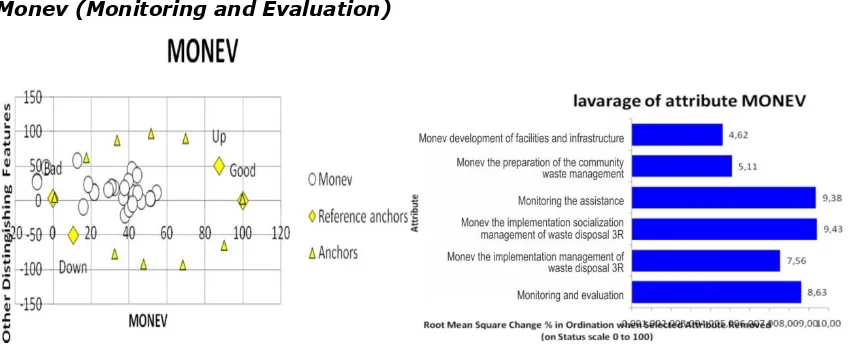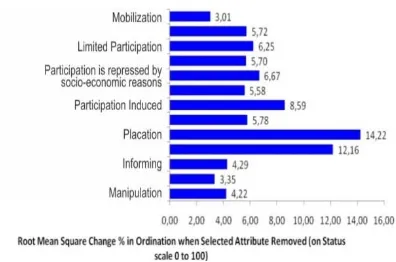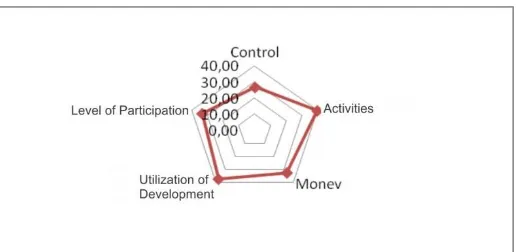861
Women Empowerment on Waste Management
in Sub-District of Dau, Malang Regency
*
Wike, Harsuko Riniwati and Endah Setyowati
Master of Women’s Studies, School of Postgraduate, Brawijaya University, Malang;
*
Corresponding author: riniwatisepk@gmail.com
Abstract
This paper aims to explore women empowerment in waste management in Sub-District Dau, Malang. This research used questionnaire to obtain data and then the data have been analyzed by using MDSs in order to assess the index and sustainability on women empowerment through a 5 dimensions. The results of analysis of the dimensions are Control (26,71), Implementation (39,36), Monev or Monitoring and Evaluation (32,63), Development Utilization (37,44), Level of Participation (33,45). The index shows that it is lower level. Therefore, if it is to maintain or improve the sustainability status of women empowerment "less" to "good" it is necessary to manage the sensitive attributes that affect the five dimensions.
Keywords: women empowerment, waste management,
Multi-Dimensional Scaling (MDSs).
Introduction
It is undeniable that women have been left behind comparing with the counterpart in many activities. This means that women have some burdens to perform such as workload, paid job, and else. Their duties cannot be valued with money. In other hand, women have some obligations to take care and nurture activity in private domain. Their activity in private domain is mostly through household activities, and the background of patriarchal and hierarchical cultural values that are deeply rooted in Indonesian society. Women's helplessness is well-founded due to many factors perceive by underestimated in social stratification. Women's abilities are still considered under men so the opportunity to absorb factors of production also left behind the men. This dissolution is felt so clearly in the economic and occupational sectors (Kurniawati, 2016). As women traditionally have position in private domain, thus it will create the task job performed by them to take care a home. Taking care of households is including to manage the cleanness of home through applied on waste management.
862 of community and women empowerments. Meanwhile, this location have population is approximately 58,717 people, with 29,018 of the population is women.
In additional, the household as the smallest part of the community is a very effective to make an awakening and awareness in how to tackle the environmental problems; in this case, women as a mother or being herself have a pivotal point to educate and to create the awareness to prevent and to solve the environmental problem for family members, for instance. The main role of women in family have been explained by a liberal Feminist Mary Woltonescraft who said that women will be more inclined to manage their families, especially their children, rather than wasting time and energy for useless entertainment. Optimizing the role of women is something that can improve the position of women in society (Kompasiana, 2015).
Literature Review
This study uses variables developed from the results of several studies as identified such as female participation in waste management (Chaerul, et al., 2014; Andarani & Goto, 2013; Rahman, et al., 2014), increasing the role of women on waste management (Kolbe 2014), the importance of monitoring and managing environmental impacts (Chen 2014), women empowerment on controlling the income from the 3Rs (Kaushal & Singh 2016), women’s participation on microfinance (Sahoo 2015, Mohapatra & Sahoo 2016), the role of women in decision making (Butt and Victors, 2014), the role of women on technology usage ( Antonio and Tuffley,
This study used secondary data, which is the data collection had been conducted by used the questionnaire. Women who participated on this study had answered the questionnaires. In order to analyze the participation of women in waste management, this study used a structured questionnaire included variables and indicators such as type of participation, controlling, activities, monitoring and evaluating, using the results of activities, and stages of participation. Meanwhile, in terms of data analysis, this study used Multi-Dimensional Scaling (MDS) with Rapfish
approach. This method is used to find out index of woman empowerment level in waste management.
Results and Discussion
This study result on some points as follows:
Control
863 From Figure 1 shows that the ecological dimension sustainability index (of 26.71) is in the range 25-49.99 which means less influence. Therefore, the control is less influential in terms of making decisions.
Figure 2 shows that the attributes of decision making (control) are taking part in the decision-making process and utilizing the products achieved from community activities. This is indicated by the leverage value of those attributes which is greater than the other 8 attributes. Thus, it can be said that improvements is required to perform the best control and should be able to take an advantages the successful of community activities.
Activities
a.
b.
From Figure 3, the index of ecological dimension sustainability status of 39.36 on this value is 25-49.99 that means is less influential on activities.
Figure 4 shows that the attribute of activity dimension is greatly influenced by an integrated waste treatment plants to maintain waste management. This is indicated by the leverage value of the attributes is greater than the other 5 attributes. Thus, it can be said that for the effective and good activity of waste management is need to increase the awareness on a good waste management and also need an integrated waste processing plants.
Monev (Monitoring and Evaluation)
Figure 3. Status of Empowerment on
Activities
Figure 4. Sensitivity of Attribute on Activities
Figure 5. Status of Empowerment on
Monitoring and Evaluating
864 From Figure above, the ecological dimension sustainability index (32.63) is in the range of 25-49.99 which means less influence. Based on this status can be concluded that it is less influential on empowerment.
Based on Figure 6, the attributes of the monev dimension that affect this dimension are the implementation of socialization on the temporary dumps of integrated 3R as well its accompaniments. This is indicated by the leverage value of those attributes which is greater than the other 6 attributes. As the result, it is necessary to improve the implementation of the socialization itself and to need for assistance in the implementation of monev.
Utilization of Developments
Figure 7 shows that the ecological status sustainability index of 37.44 is in range 25-49.99 which it means a less influential. Thus, this means that the empowerment is less influenced by the status of utilization of development.
Figure 8 shows that the development utilization dimension is greatly affected by the consumer on goods produced by 3R. This is indicated by the leverage value of those attributes which is greater than the other 3 attributes. From those attributes, the marketing and selling the products need to be improved and the 3R products need to be designed based on the consumer needs.
Level of Participations
Figure 7. Status of Utilization of
Developments
Figure 8. Sensitivity of attribute on
Development Utilizations
Figure 9. Status of Empowerment on
Participaton Level.
Figure 10. Sensitivity of Attribute on level
865 Figure 9 shows that the index of ecological dimension sustainability status of 33.45 is in range of 25-49.99 which it means a less of influence on empowerment; thus the level of participation is not affected by empowerment.
Based on Figure 10, the attributes of the dimensions of participation level is affected by the dimension of placation and consultation. This is indicated by the leverage value of those attributes which is greater than the other 13 attributes. By those attributes, it can be argued that placation and consultations are needed to create the energetic participations.
Figure 11. Status of sustainability of women’s empowerment in waste
management.
Figure 11 shows the picture of combination of 5 dimensions of women's empowerment in waste management. Overall, the index of sustainability index of dimensions is 32.72. This indicates that those of decision-making (Control), activities, monev, utilization of development and participation level resulting on appearing to be less empowered in the site of study. Based on the figure above, if the index is close to 100, it shows the best status of empowerment. Meanwhile, the value is close to 0, it shows the worse status of empowerment. From the 5 dimension above, the index of decision making (control) has a bad value on empowerment. This study suggests that the right action is required for decision making by getting involve from community who are concerning on women's empowerment, particularly in waste management in Sub-District of Dau, Malang.
Conclusions
This study has some points to be concluded, as follows:
1. The biggest influence to improve empowerment is the dimension of decision making is taking part in the decision-making process, and utilizing the results achieved from community activities.
2. It can be said that for the effective and good activity of waste management is need to increase the awareness on a good waste management and also need an integrated waste processing plants.
3. As the result is necessary to improve the implementation of the socialization itself and to need for assistance in the implementation of monev.
4. The marketing and selling the products need to be improved and the 3R products need to be designed based on the consumer needs.
5. It can be argued that placation and consultations are needed to create the energetic participations.
866
Recommendations
This study recommended some points as follows:
To improve the empowerment on decision-making (control) dimensions is required to take part in the decision-making process and should be able to utilize the results achieved from community activities.
To increase the empowerment on activity is needed to create an awareness to manage the waste and to provide the integrated processing plants and not to dispose any waste in any places.
To increase the empowerment of development utilization is required some activities relating with marketing and selling the 3rs products.
In order to improve the empowerment of women in waste management in sub-district of Dau, Malang is needed to make joint cooperation with other stakeholders or governments.
Acknowledgements
The researchers of Women’s Studies from the School of Postgraduate, Barawijaya University, have conducted this study. We thanked to the school as this institution supported and gave funds to finish the study.
References
Arief, S. (2015). Pengelolaan sampah malang raya menuju pengelolaan sampah terpadu yang berbasis partisipasi masyarakat. Malang: Universitas Muhammadiyah Malang.
Kurniawati, D. (2016). Pemberdayaan perempuan melalui pengelolaan Bank Sampah Pujarima di Kampung Pujokusuman Rw 5 Yogyakarta (Skripsi). UIN Sunan Kalijaga, Kalijaga.
Theresia, A., Andini, Krisnha, S., Nugraha, P. G. P., & Mardikanto, T. (2014).
Pembangunan berbasis masyarakat: Acuan bagi praktisi, akademis, dan pemerhati pengembangan masyarakat. Bandung: Penerbit Alfabeta Bandung. Andarani, P., & Goto, N. (2013). Potential e-waste generated from households in
Indonesia using material flow analysis. J Mater Cycles Waste Manag, 16, 306– 320.
Chaerul, M, Fahruroji, A. R., Fujiwara, T. (2014). Recycling of plastic packaging waste in Bandung city, Indonesia. J. Mater Cycles Waste Manag, 16, 509–518. Rahman, M. O., Hussain, A., & Basri, A. (2014). A critical review on waste paper
sorting techniques. Int. J. Environ. Sci. Technol., 11, 551–64.
Kolbe, K. (2014). Knowledge, attitudes and behaviour regarding waste management options in Romania: Results from a school questionnaire. Journal of Economic Development, Environment and People, 3(4).
Rachel J. C., Chen, & Rachel J. C. (2014). An integrated sustainable business and development system: Thoughts and opinions. Sustainability, 6, 6862-6871. Kaushal, S. L. And Singh, Balbir. (2016). A Study of Women Participation in
MGNREGA in Himachal Pradesh. Productivity, Vol. 56 (4), January-March.
Masanyiwa, Z. S., Niehof, A. T., & Catrien, J. A. M. (2014). Gender perspectives on decentralisation and service users’ participation in rural Tanzania. J. of Modern case study of Lahore. Journal Of Political Science Xxxii.
Antonio, A., & Tuffley, D. (2014). The gender digital divide in developing countries.
867 Rogers, J. G., & Franzen, A. B. (2014). Work-family conflict: The effects of religious context on married women’s participation in the labor force. Religions, 5, 580–



